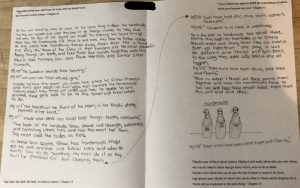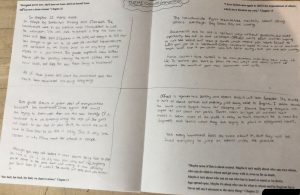Standard 5 – Educators implement effective planning, instruction, assessment and reporting practices to create respectful, inclusive environments for student learning and development
Before deciding to go back to school, I spent a number of years working within Early Learning and one thing that I found incredibly beneficial from both Early Learning and Elementary classrooms was the plan for the day clearly written out on the board before each day or class began. That is not to say that Secondary teachers do not also give a plan to their classes, but in my experience, they look different. In my Practicums, I would take a few minutes after attendance and Mindfulness to go over the plan for the class. Discuss with students what was being completed from the previous class, what was being started on and I would also give time for feedback and questions at that point. I found that it helped to ground students in what was to come and took away the wondering of if there would be time given to complete an assignment in class. Now, they say ‘the best laid plans of mice and men often go awry’ and as any educator knows, that happens. So despite the fact that I would have a plan for the day, the week, the unit etc. I made sure to be flexible and adapt as was needed. I would adjust the plan for the day when I could tell my learners were feeling exhausted and overwhelmed. Grade 12 is challenging, so despite having planned as in-class group assignment for a specific class, that might have turned into a work block, because that supported the learners in the classroom. I found it incredibly beneficial to go over items that were handed out; even as an adult, sometimes if you are just handed a piece of paper, you may not read it. So by reading through, stopping, talking and discussing, even those learners in the classroom who may not read the handout themselves are informed.
I used a variety of formative assessment strategies over the course of my Practicum experience, from Table-Top Twitter, to giving students a prompt at the beginning of film class and having them respond on sticky-notes, in class discussion and one -on-one check-in’s for understanding. While reading through The Handmaid’s Tale, as a way to assess understanding and comprehension, I had students find a quotation from the chapter and explain why the quotation that they had chosen was significant to the chapter and to the novel.
When it came to summative assessment, I wanted to shy away from what is often typical in an English or Humanities class, the summative essay and test. Now, that is not to say that the learners in the class did not write tests and/or a literary essay, but I did not want the majority of the effort to go in that direction. I was talking with my Practicum Mentor about this, and they suggested that I find key quotations and then have the learners connect them; this turned into an amazing thing! I found quotations and put them in the four corners of an 11×17 sheet of paper and I gave the chapter numbers that the quotations had been taken from. Then I projected the prompt for the class, answered and questions, clarified things, and they began to create. I did not say that anyone needed to draw, but I also knew that there were quite a few learners that liked to draw, so as part of the instructions I expressed that drawing was allowed, even encouraged, but that there needed to be words along with the illustrations. Below are a few responses.




As writing/drawing wrapped up, I asked how it felt to demonstrate knowledge in this way versus a more formal test. Many of the learners expressed how they enjoyed being able to illustrate their ideas, others were not totally excited by the format but still said that they would be happy to try something different than they were typically use to.
